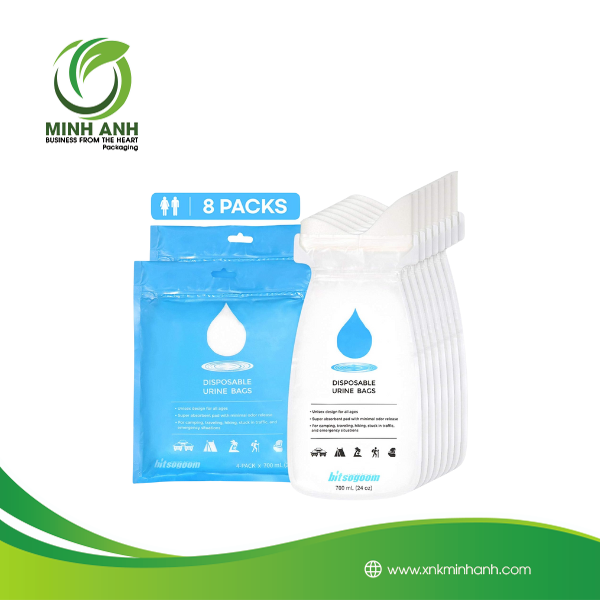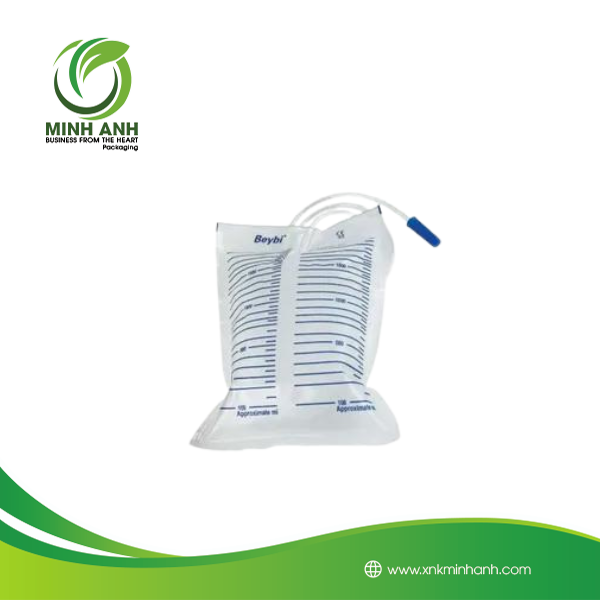News
Urine Bags Production Process
Urine Bags, also known as urine bags, are an indispensable part in today’s medical field. They are designed to safely and hygienically collect urine, making urine management and disposal in hospitals, healthcare facilities, and even at home easy and convenient. convenient. Urine bags not only help patients maintain personal hygiene but also assist the medical team in monitoring and evaluating health status through urine quantity and quality. To meet the high-end and diverse needs of the medical industry, the production process of Urine Bags needs to strictly comply with quality and hygiene standards.

Ingredient
In the production process of Urine Bags, choosing raw materials is the first important step that determines the quality and features of the final product. There are two main types of materials commonly used: PVC (Polyvinyl Chloride) and PE (Polyethylene). Each of these materials has outstanding properties, meeting different product requirements.
PVC plastic is the most popular material in the production of Urine Bags because of its durability, water resistance and low cost. PVC plastic is also easily softened and flexible through the process of adding additives, helping the final product have the necessary softness, creating a comfortable feeling for the user. However, in recent years, the use of PVC has been carefully considered due to concerns about its effects on the environment and consumer health.
PE (Polyethylene), an alternative to PVC, is known for its safer health and environmental properties. PE is a highly flexible, non-toxic and recyclable plastic. Urine Bags products made from PE are often softer and more comfortable, but production costs can be higher than PVC.
In addition, other materials such as silicone and latex are also used in some special cases, but they are less popular due to their high cost and complex production technology requirements.
Urine Bags Production Process
The Urine Bags production process includes many complex and thorough steps, from design to production and quality control. Below are the detailed steps:
1. Product Design and Development
- Determine Requirements: Determine the features, dimensions, and special requirements of the urine collection bag, based on user needs and technical requirements.
- Product Design: Use design software to create 3D models, and calculate the product’s bearing capacity and durability.
2. Prepare Ingredients
- Material Selection: Based on the design, choose the appropriate plastic such as PVC or PE.
- Raw Material Inspection: Check the quality and suitability of raw materials before putting them into production.
3. Production
- Softening Raw Materials: Raw materials are heated to soften, preparing for the product formation process.
- Film Blowing or Molding: Use a film blowing machine to create thin layers of plastic or a molding machine to shape the bag according to the designed mold.
- Welding and Shaping: Welding parts of the bag together and cutting off excess, while forming necessary structures such as release valves.
- Printing and Labeling: Print necessary information on bags and label them, including instructions for use.
4. Quality Check
- Check Size and Shape: Ensure that each bag meets size and shape standards.
- Leak Test: Test the bag’s load-bearing capacity and tightness to ensure no leaks occur.
Functionality Check: Test the valves and the bag’s ability to open and close.
5. Packaging and Shipping Preparation
- Packaging: Urine bags are carefully packaged in sterile packaging to ensure hygiene.
- Check Packaging: Check packaging to make sure the product is stored safely during transportation.

Quality verification
To ensure Urine Bags meet quality and safety standards, each product must undergo a strict quality testing process before being distributed to the market. Below are the main quality inspection steps:
1. Physical Examination
- Durability Test: Test the bag’s durability by applying force to the product to ensure that it can withstand the weight of urine without leaking or breaking.
- Check Size and Shape: Ensure that the size and shape of each bag meets design standards.
2. Function Test
- Check the Relief Valves and Opening and Closing: Check the relief valves and opening and closing mechanisms to ensure they operate smoothly and do not cause leaks.
- Trial Test: Simulates actual usage to evaluate the overall performance and safety of the urine bag.
3. Chemical Testing
- Check the Safety of Raw Materials: Analyze raw material samples to ensure they do not contain toxic or allergenic substances.
- Sterility Assessment: Test to ensure the product does not contain bacteria or viruses that could be harmful to the user.
4. Ensure Compliance with Standards
- Regulatory Compliance: Ensure products comply with international regulations and standards, such as FDA (US Food and Drug Administration) or CE (Europe).
- Perform Periodic Inspections: Carry out periodic inspections to maintain product quality and update new standards.
Storage and Transportation
After the product has passed quality inspection, preserving and transporting Urine Bags becomes extremely important to ensure they are not damaged or unhygienic before reaching consumers.
- Carefully Packed: Each bag is packed in sterile and moisture-proof packaging to protect them from bacteria and damage.
- Storage Under Proper Conditions: Store the product in a cool and dry place, away from direct light and high temperatures.
- Safe Transportation: Use appropriate means of transportation and ensure products are neatly arranged, avoiding impact or great pressure.





